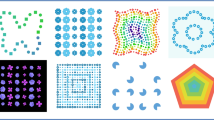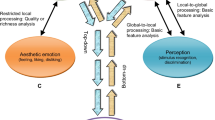Summary
Subjects were asked to construct colored pictures which they considered to be aesthetically maximally pleasing or unpleasing. These two groups of pictures were analyzed and it was found that the aesthetically pleasing pictures showed a statistically significant increase in the number of higher order configurations of color elements and a greater hierarchical organization of such configurations. Furthermore, the higher order configurations of the aesthetically pleasing pictures were of a more complicated structure than the higher order configurations of the aesthetically unpleasing pictures. Considering these results, the hypothesis was raised that aesthetical appreciation may be based on the reduction of uncertainty “against the resistance” of a complicated system of ordering relations within a stimulus. This hypothesis was tested and verified in a subsequent experiment.
Zusammenfassung
Vpn mußten unter standardisierten Bedingungen zweidimensionale Farbmuster herstellen, die ihrer Meinung nach ästhetisch maximal befriedigend, bzw. maximal unbefriedigend waren. Die beiden Gruppen von Bildern wurden untersucht, wobei sich eine Gruppe von ästhetisch befriedigenden und zwei Gruppen von ästhetisch unbefriedigenden Bildern zeigten. Eine weitere Analyse ergab, daß sich die ästhetisch befriedigenden Bilder von den ästhetisch unbefriedigenden statistisch darin unterscheiden, daß bei den ästhetisch befriedigenden Bildern die Farbelemente in hohem Maße zum Aufbau komplizierter und tiefer Hierarchien von Zeichen höherer Ordnung verwendet wurden, wohingegen bei den ästhetisch unbefriedigenden Mustern übergeordnete Konfigurationen entweder nur in einfacher Form und flachen Hierarchien auftreten (1. Gruppe) oder Zeichen höherer Ordnung gar nicht vorhanden sind (2. Gruppe). Aufgrund der empirischen Ergebnisse wird die Hypothese aufgestellt, daß ästhetische Befriedigung auf Unbestimmtheitsreduktion „gegen Widerstand“ zurückgeführt werden kann. In einem nachfolgenden Experiment wurde diese Hypothese geprüft und bestätigt.
Similar content being viewed by others
Literatur
Attneave, F.: Informationstheorie in der Psychologie. Bern: Huber 1965
Berlyne, D. E.: Measures of aesthetic preference. Sciences de l'Art, special number, 9–23 (1965)
Birkhoff, G. D.: A mathematical theory of aesthetics. The Rice Institute Pamphlet 19, 189–342 (1932)
Dorfmann, D. D., McKenna, H.: Pattern preference as a function of pattern uncertainty. Canadian J. Psychol. 20, 143–153 (1966)
Dörner, D.: Eine informationstheoretische Methode zur Bestimmung der ästhetischen Wirkung von Flächenmustern. Psychol. Forsch. 33, 345–355 (1970)
Eysenck, H. J.: The experimental study of the good “Gestalt” — a new approach. Brit. J. Psychol. 49, 344–364 (1942)
Fechner, G. Th.: Vorschule der Ästhetik. Leipzig: Breitkopf & Härtel 1897
Gunzenhäuser, R.: Informationstheorie und Ästhetik. In: Kybernetik(Hrsg. H. Frank) Frankfurt a. Main: Umschau Verlag 1966
Frank, H.: Kybernetische Analysen subjektiver Sachverhalte. Quickborn: Schnelle 1964
Hochberg, J. E., McAlister, E.: A quantitative approach to figural “goodness”. J. exp. Psychol. 46, 361–364 (1953)
McWinnie, H. J.: A review of research on aesthetic measure Acta psychol. (Amst.) 28, 363–375 (1968)
Munsinger, H., Kessen, W.: Uncertainty, structure and preference. Psychol. Monogr. 78, No. 586 (1964)
Raab, E.: Der ästhetische Eindruck als Funktion der „objektiven“ und „phänomenalen“ Komplexität von Bildern. Institutsbericht, Graz 1972
Ritter, J.: Historisches Wörterbuch der Philosophie. Darmstadt: Wissenschaftliche Buchgesellsch. 1971
Schwarz, A., Werbik, A.: Eine experimentelle Untersuchung über den Einfluß der syntaktischen Information der Anordnung von Baukörpern entlang der Straße auf Stimmungen des Betrachters. Z. exp. angew. Psychol. 18, 499–511 (1971)
Terwillinger, R. F.: Pattern complexity and affective arousal. Percept. mot. Skills 17, 387–395 (1963)
Vitz, P. C.: Preferences for rates of information presented by sequences of tones. J. exp. Psychol. 68, 176–183 (1964)
Vitz, P. C.: Affect as a function of stimulus variation. J. exp. Psychol. 71, 74–79 (1966)
Weber, E.: Grundriß der biologischen Statistik. Jena: VEB Gustav Fischer 1961
Werbik, H.: Informationsgehalt und emotionale Wirkung vom Musik. Mainz: Schott 1971
Author information
Authors and Affiliations
Rights and permissions
About this article
Cite this article
Dörner, D., Vehrs, W. Ästhetische Befriedigung und Unbestimmtheitsreduktion. Psychol. Res 37, 321–334 (1975). https://doi.org/10.1007/BF00309726
Received:
Issue Date:
DOI: https://doi.org/10.1007/BF00309726




